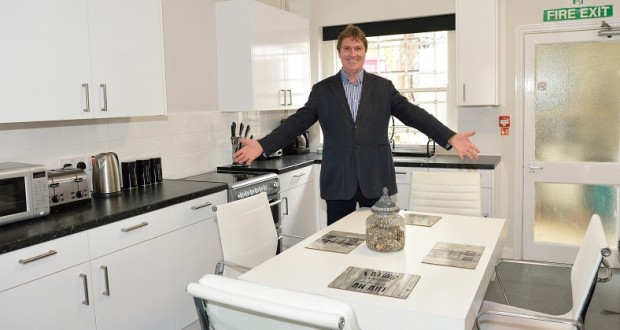First, the good news: East London charity The Spitalfields Crypt Trust has received a donation of furniture from housing association L&Q. The Trust, which celebrates its 50th birthday this year, provides a variety of services for over 150 recovering and current drug and alcohol addicts every week.
Graham Marshall, CEO of The Spitalfields Crypt Trust, was delighted with the gift, commenting, “One of our supported houses in East London, where people in recovery from addictions start building a more independent life, was long overdue a makeover. L&Q very kindly donated some virtually new, high quality furniture including sofas, armchairs, tables and chairs. They also sent us some lovely artwork and soft furnishings which have really cheered up the houses. The donation was so large that we have been able to place items in all four of our supported houses right across London, and give some to a long term resident just rehoused into an L&Q flat. Fantastic! Thank you so much L&Q for your longstanding and hugely generous support.”
The donated furniture had previously been used in one of L&Q’s show homes at City Mills, one of its recent regeneration projects in Haggerston. This is where the less good news comes in. L&Q delivers what it refers to as a “significant part of the capital’s Shared Ownership properties.” The City Mills location includes some of these properties: and buying a one-third share of a two bedroom flat costs a minimum of £182,000.
L&Q says its scheme gives “local renters a chance to step onto the property ladder”. That will only hold true if you can afford the mortgage repayments on £182,000 – which may be around £850 – plus the rent on two thirds of the flat too (L&Q do not advertise what that is, but it could be as much as another £400 per month. Assuming you are prepared to spend 50% of your net income on housing costs (and few experts suggest you spend more), you would need an income of around £37,500 – just below the threshold (£42,385) at which you would have to pay the 40% higher rate income tax.
It gets worse. The idea behind shared ownership is that as you age and your earnings increase, the plan is that you can buy additional shares in your property. However, the cost of these shares increases as the years go buy – particularly if your home is in an area where house prices are going up fast. L&Q seem to anticipate high prices rises in City Mills, as they describe it as a “highly desirable location”. A shared owner would, therefore, have to secure a considerable salary hike to be able to afford to buy the whole property – which would cost around £600,000 at today’s prices, and the equivalent at tomorrow’s prices.
Most shared ownership schemes less a chance to get on the property ladder as a chance never to get off it. Pay a social rent, and you can spend your disposable income on a range of goods and services – stimulating the local economy and generally protecting local jobs. Pay shedloads of cash into a mortgage to cover a percentage of your flat, and you will never get back more than that one third of the value – while the mortgage money you spend will play its part in keeping house prices high.
The reality of the situation seems to have escaped L&Q. Cathy Lloyd, L&Q Sales Director, issued the following official statement: “We’re incredibly excited about The City Mills development. The first phase was extremely successful and signalled the need for more housing in the Haggerston area. We look forward to providing the local community with this range of affordable and contemporary properties throughout 2015 and 2016.” It was the Coalition which started to use the word “affordable” to mean “expensive”, rather than “at a cost you can afford”. Housing Associations were initially worried about this – but many of them seem to have adopted the new terminology themselves. It doesn’t make their charges any easier to pay.
The L&Q sales blurb for City Mills as: “Ideal for first time buyers, families and young professionals, future residents will benefit from excellent nearby transport links which include Hoxton and Haggerston station as well as surrounding popular hotspots such as Dalston, Shoreditch and Hackney. Haggerston itself is now firmly placed within this ‘Hipster Triangle’ and has upheld many of its London village qualities. Lifestyle pursuits include the much visited City Farm, nearby Columbia Flower Market and the Regent’s Canal, aligned with popular bars and restaurants.”
[Adverts]
This approach is typical of many recent developments across London which have been described by the London Tenants Federation as “gentrification”. Developers are so busy chasing, competing for, young professionals – the only people who can afford the unaffordable “affordable” charges – that huge numbers of people are being left behind, willing and able to pay a fair rent, but not able to fund developers’ mega-profits.
L&Q’s involvement in shared ownership is just one example of how housing associations are diversifying these days. While initially they were developed to widen choice in social and near-social rented housing, now they rent and sell. L&Q’s own description of what it does makes it clear how much housing associations now take on: it says it “delivers homes people can afford, including help onto the housing ladder through options such as shared ownership. L&Q also rents and sells homes on the open market.”
It is not just in the field of housing that Housing Associations are diversifying: now they spend tenants’ rent money on issues such as employment, training, youth work and public health. L&Q describes itself as “committed to shaping healthier, happier neighbourhoods across the capital”, for example. Again, this leaves lower paid residents contributing proportionately more of their incomes to public services. Where a training course used to be provided at a local FE college, for example, it may now be laid on by a housing association. In the first case, the course would have been funded from general taxation, which is means-tested. A course provided by a housing association would be funded from tenants’ own rents: paid for by the lowest paid. There may be some government subsidy in some cases: which would mean that taxpayers’ money is spent on an extra layer of bureaucracy rather than on the service itself.
Let’s look at what L&Q does, in its own words.
-L&Q invests in people and communities. Over the coming year, the L&Q Foundation will invest £7 million on community initiatives, helping residents improve their life chances.
-In May 2014, L&Q launched L&Q Apprenticeships, an employment scheme available exclusively to its residents, and hopes to get more than 100 people into employment before the end of the financial year. As well as this new L&Q Apprenticeships scheme, L&Q offers more than 100 apprenticeships each year for residents and non-residents alike, through its subsidiary and external contractors. For example, in 2014/15, Quadrant Construction, L&Q’s dedicated construction subsidiary, will recruit more than 50 apprentices.
Goodness knows what “helping residents improve their life chances” means, or why a housing association (rather than Council social services or the local education authority) is the best provider of these services. Has anyone asked the tenants whether they want to pay rent in order to improve their life chances, or whether they would prefer to invest in the repairs service? Would tenants’ life chances improve if the £7 million was knocked off their rent, allowing them all a bit more spending money?
[Adverts]
Despite its extra spending, L&Q made record profits last year, according to industry magazine Inside Housing. It reports that in the 2014/15 financial year, LAQ had a turnover of £642 million and a post-tax surplus (profit) of £209 million: in other words, just under £1 in every three of its income just went to profits.
Waqar Ahmed, L&Q Finance Director, told Inside Housing that there were three main reasons for the large surplus: positive sales of both market homes and shared ownership properties, ongoing efficiencies (usually a euphemism for “cuts”) and a “continuing benign interest environment” (probably “low interest rates make borrowing cheaper). However, he also admitted, “This year, we outperformed our budget by around £50m, which gives us a great platform going into year one of our new financial plan.” In other words, L&Q were budgeting to make around £150 million profit, but they ended up with £200 million profit. Three quarters of the profit, £176 million, came from rents paid by tenants in social housing – with just under half of what tenants pay going direct to profits rather than services.
L&Q’s profits may seem shocking – high enough to afford giving all staff a pay rise and all tenants a rent rebate. Indeed they are: this is the second largest surplus a housing association has ever had, with the largest surplus (Peabody, last year) being largely due to accounting conventions around a merger. In mitigation, though, it has to be said that the Government is no longer giving housing associations capital grants to build new homes. It expects them to make a profit to finance new building: in other words, today’s tenants are paying for tomorrow’s new homes.
Housing associations are also expected to borrow money to build new homes. L&Q’s debts (borrowings) are around 50% of the value of their assets (houses) – which is relatively low, as the maximum permitted is a “gearing” of 80%. It’s ironic that while the Government is condemning borrowing (the “deficit”) as having had a negative effect on the economy overall, it is encouraging borrowing by housing associations to deliver much needed new homes. It just goes to show that investing in housing is… well, as safe as houses really. It certainly allows you to be able to donate the odd show home’s worth of furniture to a worthy but underfunded charity seeking to make up for the gap in the funding of statutory services.
[Adverts]
 East London News A Force for the community…
East London News A Force for the community…





